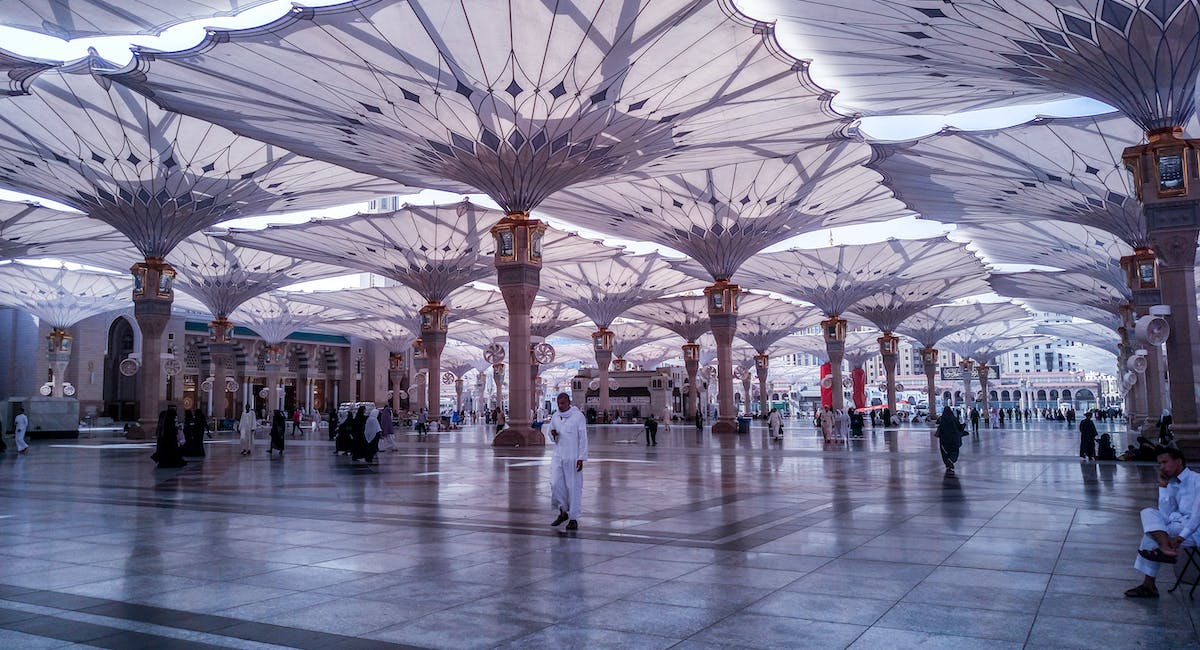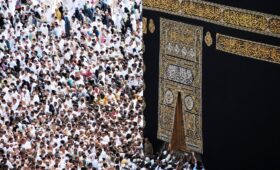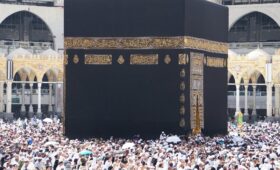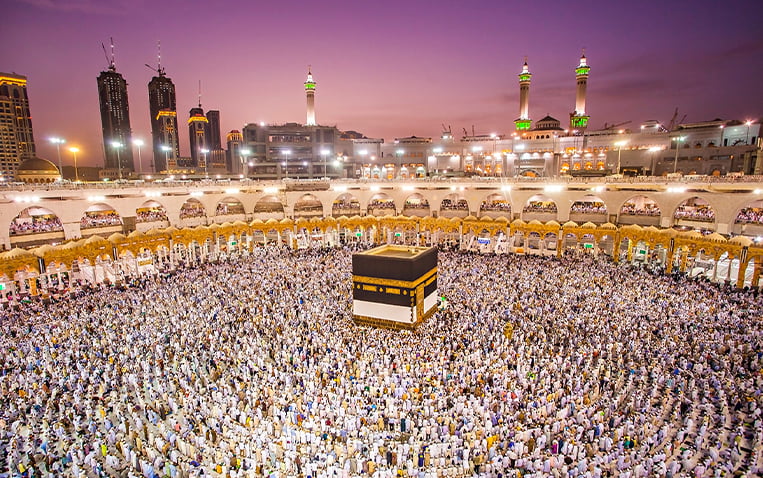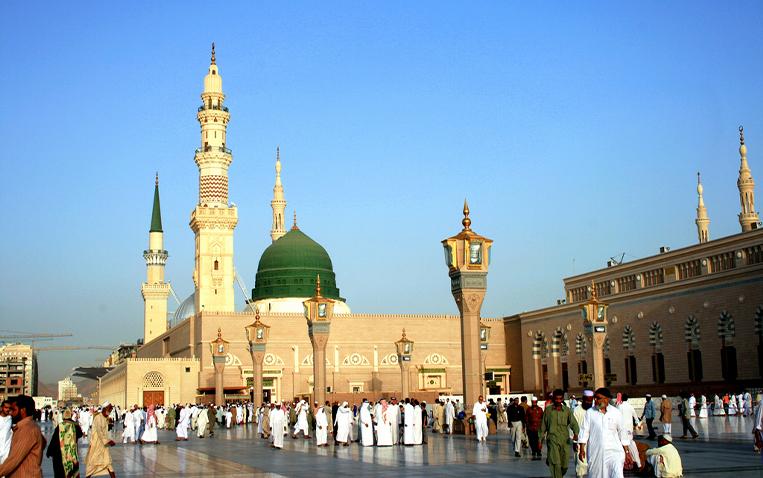Umrah means “to visit a populated place” in Arabic.
This occasion is a significant but optional pilgrimage for Muslims to the Makkah holy city of Masjid al-Haram. Most pilgrims make the Umrah trip either during Ramadan or in Rajab and Sha’ban, the two Islamic lunar months that precede it. Muslims believe there is more mercy, greater acceptance of prayers, and a higher reward for worshiping during these holy months.
A Muslim can conduct the Umrah at any age and is not restricted in the number of times they can do it in their lifetime. But women under 45 must go with a mahram, a male relative older than 17. Tour groups are open to women over 45 who do not require a mahram.
Umrah is one of the most beautiful Sunnahs of the Prophet Muhammad (Peace Be Upon Him). Every year, millions of Muslims engage in this act of prayer. With love, appreciation, passion, and desire, you should seek Umrah, considering its boundless blessings. You will discover everything there is to know about Umrah in this guide.
What is the purpose of the Umrah?
Umrah pilgrimages serve a spiritual purpose:
- Connecting to Allah (Subhanahu Wa Ta’ala–the exalted)
- Pleasing him
- Reaping the rewards associated with worshiping him
Anyone undertaking this spiritual journey purifies their body, heart, soul, and mind from sins they may have committed in the past. Umrah is an Islamic pilgrimage to Makkah, one of the holiest cities, for religious worship and ritual. While not obligatory, Umrah should still be considered highly recommended for Muslims with the physical and financial capacity to undertake it.
Umrah serves to draw closer to Allah, seek forgiveness for past crimes, and engage in acts of devotion and submission. Umrah pilgrims engage in rituals such as Tawaf (circumambulating around the Kaaba), Sa’i (walking between Safa and Marwah), and cutting their hair, symbolizing purification, humility, and spiritual renewal. Umrah allows Muslims to separate from worldly worries while deepening their dedication and devotion towards Allah.
What is done during Umrah?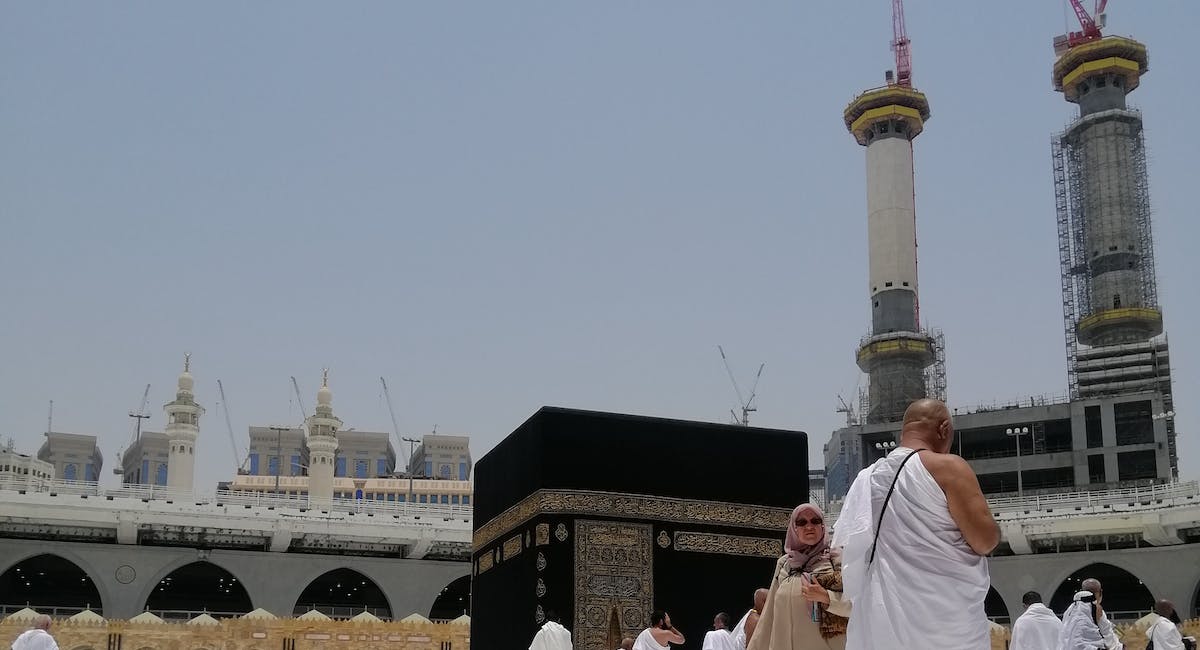
Muslims place great importance on the Umrah, a pilgrimage to Makkah, one of Islam’s holiest cities. The Umrah is an optional pilgrimage that can be done any time of the year, unlike the Hajj, which is an obligatory trip with set rituals. The Umrah rituals comprise a sequence of acts of worship signifying the unity of Muslims and their allegiance to Allah.
The first crucial step in the Umrah process is the intention (niyyah), in which the pilgrim expresses their desire to perform Umrah exclusively for Allah’s benefit. When pilgrims arrive in Makkah, they enter the Ihram, a holy state of dedication and purity denoted by particular clothing for men and modest clothing for women.
In the following ritual, pilgrims perform Tawaf, which circles the Kaaba seven times in a counterclockwise direction to represent the devotion of Muslims to Allah and the unity of the Muslim ummah (community).
Following Tawaf, pilgrims engage in Sa’i, which involves walking between the hills of Safa and Marwah seven times. This act honors the deeds of Hagar, the Prophet Ibrahim’s (Abraham’s) wife, as she searched for water for her son Isma’il. The pilgrim ends by shaving or cutting their hair to symbolize kindness and the cleansing of sins.
These customs lead to spiritual purity and closeness with Allah, which promotes equality and solidarity among Muslims from all walks of life.
Types of Umrah
Umrah-al-Mufradah
Umrah-al-Mufradah is often known as independent or non-combined Umrah and can be undertaken any time of year except for the specific dates of Hajj. Unlike Hajj, which requires pilgrims to assemble at particular sites on clear days, Umrah-al-Mufradah allows flexibility and can be undertaken whenever it suits pilgrims best.
Similar rituals such as Tawaf (circumlocution around Kaaba), Sa’i (walking between Safa and Marwa hills), and cutting hair are all performed during Umrah-al-Mufradah as combined Umrah/Hajj. Umrah-al-Mufradah gives pilgrims the freedom to choose an itinerary and timing.
That works with their schedule and personal circumstances, making it an appealing option for those wishing to perform Umrah without the constraints of specific dates. From experiencing its spiritual atmosphere to fulfilling personal vows, Umrah-al-Mufradah offers pilgrims an unforgettable pilgrimage experience outside the Hajj season.
Umrah-al-Tamattu
Hajj, in conjunction with Umrah, is known as Umrah al-Tamattu (Arabic: عمرة التمتع). This Umrah is typically performed in the month of Dhul Hijjah, right before Hajj begins. This Hajj, also called Hajj al-Tamattu, is the most popular and straightforward kind that pilgrims typically perform.
Umrah-al-Tamattu (also called an “interrupted Umrah”) takes place specifically during Hajj but before beginning Hajj rituals. Pilgrims who opt for Umrah-ul-Tamattu perform Umrah rituals before exiting Ihram state by performing Tawaf and Sa’i before departing Ihram altogether.
Once Umrah concludes, pilgrims reenter the Ihram for Hajj rituals when the days officially commence. This allows pilgrims to experience Umrah and Hajj separately, with an interval between them that symbolizes both the completion of one and the start of another pilgrimage journey.
What does the Quran say about Umrah?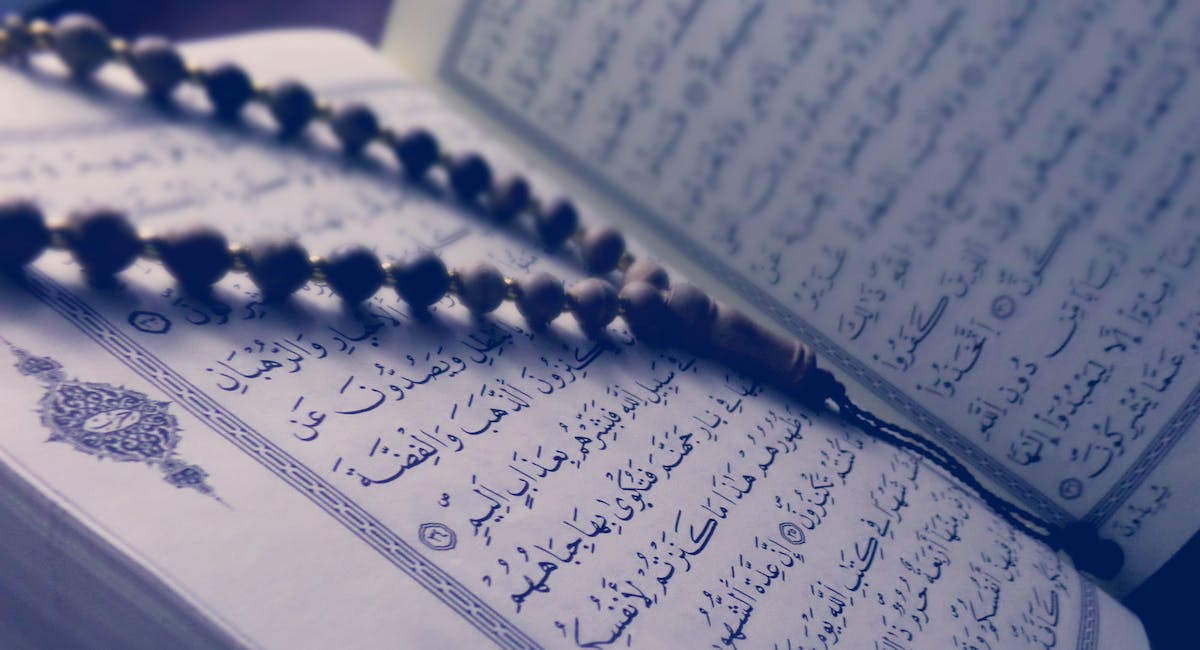
Suratul Baqarah: Verse 158
إِنَّ ٱلصَّفَا وَٱلمَرۡوَةَ مِن شَعَآئرِ ٱللَّهِۖ فَمَنۡ حَجَّ ٱلبَيتَ أَوِ ٱعتَمَرَ فَلَا جُنَاحَ عَلَيهِ أَن يَطَّوَّفَ بِهِمَاۚ وَمَن تَطَوَّعَ خَيرً۬ا فَإِنَّ ٱللَّهَ شَاكِرٌ عَلِيمٌ
“Indeed, as-Safa and al-Marwah are among the symbols of Allah. So whoever makes Hajj to the House or performs Umrah is not blamed for walking between them. And whoever volunteers is good – Allah is appreciative and Knowing.”
Surah al-Hajj:
إِنَّ الَّذِينَ كَفَرُواْ وَيَصُدُّونَ عَن سَبِيلِ اللَّهِ وَالْمَسْجِدِ الْحَرَامِ الَّذِى جَعَلْنَـهُ لِلنَّاسِ سَوَآءً الْعَـكِفُ فِيهِ وَالْبَادِ وَمَن يُرِدْ فِيهِ بِإِلْحَادٍ بِظُلْمٍ نُّذِقْهُ مِنْ عَذَابٍ أَلِيمٍ
“Indeed, those who have disbelieved and avert [people] from the way of Allah and [from] al-Masjid al-Haram, which We made for the people – equal are the resident therein and one from outside; and [also] whoever intends [a deed] therein of deviation [in religion] or wrongdoing – We will make him taste of a painful punishment.”
Is it mandatory to do Umrah?
No, Umrah is not mandatory in Islam; rather, it is recommended as a non-obligatory pilgrimage. While Hajj is one of Islam’s Five Pillars and obligatory for eligible Muslims at least once in their lifetimes, Umrah is a voluntary act of worship that can take place any time during the year except on Hajj days; individuals can decide for themselves when and if to perform Umrah depending on their intentions, circumstances, and spiritual aspirations.
What are the steps of Umrah?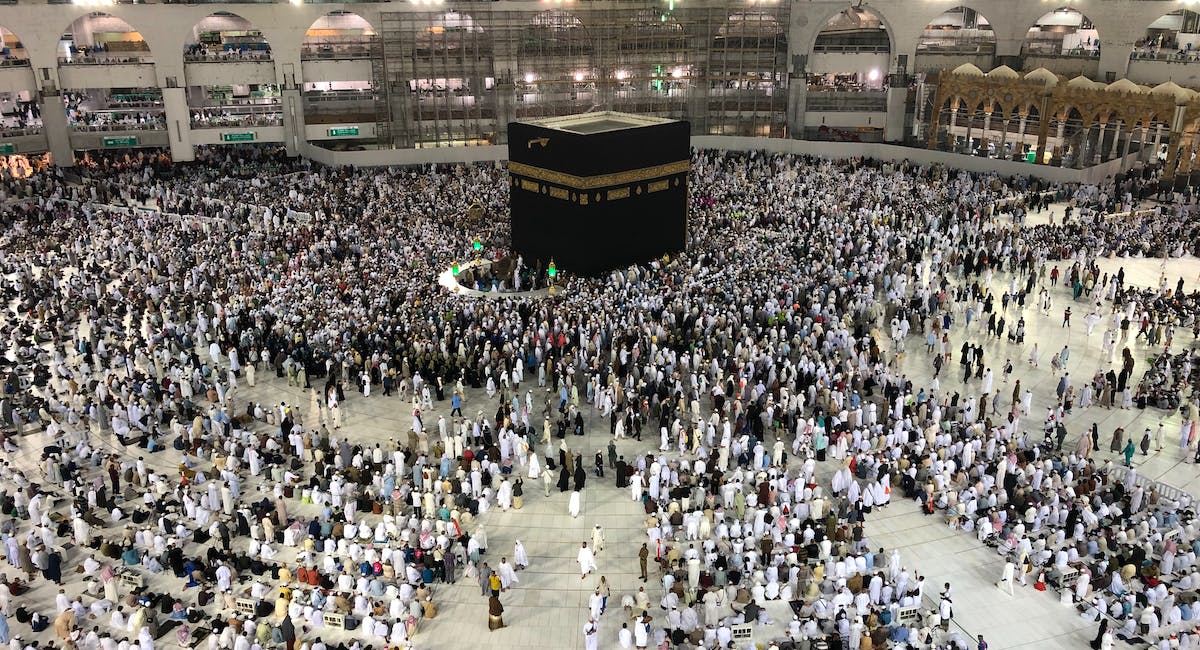
Umrah involves several rituals performed by pilgrims who journey there for this annual ceremony. Umrah pilgrims can perform these basic steps quickly and efficiently.
Additionally, additional prayers, supplications, and acts of worship may take place while in Makkah; therefore, it’s essential for pilgrims to abide by prescribed rituals as prescribed and seek assistance from knowledgeable sources if needed.
Here are its basic steps:
Ihram
Pilgrims enter into a state of consecration known as Ihram before reaching the Miqat boundary by wearing special white clothing for men and following a modest dress code for women.
Tawaf al-Qudum (Arrival Tawaf)
As soon as they reach the Kaaba in Makkah’s Masjid al-Haram, pilgrims perform Tawaf al-Qudum, which involves circumambulating it upon arrival. Although not obligatory, pilgrims are strongly encouraged to perform this act of devotion upon their arrival at Makkah.
Sa’i between Safa and Marwah
Pilgrims perform Sa’i by walking seven times between Safa and Marwa hills to honor Hagar, wife of Prophet Ibrahim, who ran between these hills in search of water for Isma’il (her son). This commemorates Hagar’s journeys while looking for her child Isma’il during their pursuit of sustenance.
Tawaf al-Umrah (Tawaf of Umrah)
Pilgrims will perform Tawaf seven times around the Kaaba.
Prayer at Maqam Ibrahim
After performing Tawaf, pilgrims offer two Rak’ahs of prayer at Maqam Ibrahim Station.
Shaving or Trimming of Hair
Once they complete the Tawaf, men must either shave their heads or trim their locks; women must cut a small section from their locks.
Tawaf al-Nisa
Tawaf al-nisaʾ (طواف النساء) is a tawaf and a two rak’a prayer which is one of the obligatory rites of hajj al-tamattu’ and al-‘umra al-mufrada. It is only after tawaf al-nisa’ that sexual pleasure from one’s spouse becomes halal to him/her.
Umrah Facts You Must Be Aware Of
To perform the Umrah pilgrimage flawlessly, one must possess specific essential knowledge about the Umrah. The pilgrims’ journey would have been more joyful and fulfilling if they understood these points.
- “To visit a populated place” is how Umrah is literally translated.
- In its current form, the Umrah pilgrimage originated during the time of Prophet Muhammad (PBUH) and is a combination of various pre-Islamic rituals that were given a pure interpretation and enhanced by Muslim prayers.
- During his life, Prophet Muhammad (PBUH) made four Umrahs.
- Before Islam was introduced, people used to walk around the Kaaba, one of the most fascinating Umrah facts.
- It is thought that Adam constructed the holy Kaaba initially, followed by prophet Ibrahim (peace be upon him) and his son Ismail (peace be upon him).
- Because the Kaaba is regarded as Allah’s home, pilgrims performing the Umrah are regarded as Allah’s guests.
- One of the critical facts regarding Umrah is that it is equivalent to performing Hajj during Ramadan, according to a Hadith.
- It is common knowledge that pilgrims should avoid using their phones as much as possible. This is done primarily to keep their focus and energy on the pilgrimage rather than elsewhere. It is one of the most important things to remember about Umrah.
- It is well known that Sa’i is performed as a tribute to Hagar, the Prophet Ibrahim’s (PBUH) wife, and her journey between the hills of Safa and Marwa to satisfy her son Ismael’s thirst.
Why do Muslims do Tawaf 7 times?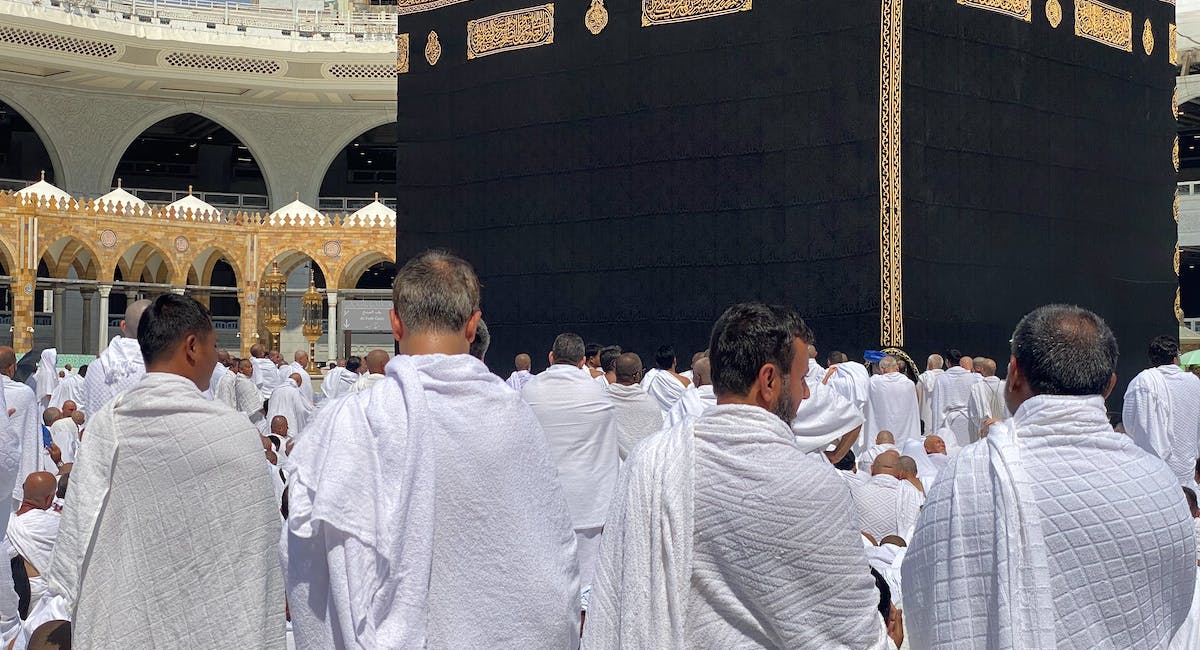
Tawaf is an act of worship wherein no matter the form or method employed to perform it, no questions should be raised as to why these prayers must be performed this way; we perform them because God commanded it and according to what was instructed and taught by his Holy Prophet.
Tawaf, which involves walking around Makkah Kaaba seven times during Umrah or Hajj, holds immense symbolic value within Islamic tradition. The number seven represents completeness and perfection and reminds pilgrims that God is One and their devotion is complete.
By engaging in this ritual, Muslims hope to imitate the angels that circled God’s throne seven times, emphasizing an important link between earthly pilgrimage and divine worship. Additionally, Tawaf marks Hajar, wife of Prophet Ibrahim, as she trekked seven times between Safa and Marwah to find water for Isma’il, whom she loved immensely.
Tawaf is an act that serves as a firm reminder to put one’s trust in Allah’s mercy while reminding one to persevere despite any obstacles in life. Tawaf represents a spiritual journey of joining, completing, and devoting, where pilgrims express their profound connection to Allah during these sacred rituals.
What is haram during Umrah?
Umrah pilgrimages set certain prohibited actions to maintain its sanctity and preserve its spiritual purity. Engaging in intimate relations, including marital ones, during Ihram (the state entered before beginning Umrah rituals) is prohibited.
Cutting nails, using scented oils or perfumes, and wearing clothing stitched by machines are forbidden on this sacred journey, emphasizing simplicity and humility as part of its journey. Furthermore, engaging in fights, gossip, or argumentative behavior is strictly discouraged to foster peace and spirituality.
These actions foster an atmosphere of devotion, discipline, and reverence for Umrah pilgrims’ sacredness, helping ensure they undertake this pilgrimage, emphasizing spiritual reflection and adherence to Islamic ethics principles.
What is the difference between Hajj and Umrah?
- Hajj is an act of worship required of every Muslim at least once in their lifetime if financially and physically capable. While Umrah is optional but highly recommended, both can be completed multiple times during one’s lifetime.
- As previously discussed, Umrah can be performed any time during the year; Hajj must occur during the first ten days of Dhul al-Hijjah in Islam.
- Umrah involves only minimal rituals and can usually be completed in just a few hours, while Hajj is more complex, taking roughly 5-6 days.
How do you shower for Umrah(Ghusl)?
Showering before embarking on Umrah is an essential ritual that symbolizes purification and prepares pilgrims physically and spiritually for this sacred journey. Ghusl, or complete ritual shower, should be performed to enter into Ihram.
The blessed state required before beginning Umrah pilgrimages is cleansing their entire bodies to prepare both physically and spiritually for Umrah pilgrimages. During Ghusl, it is customary to state one’s intention to enter the Ihram, affirming one’s commitment by repeating one’s will to enter the Ihram state before embarking upon a sacred journey.
How to Perform Ghusl?
- Drenching the entire body with water;
- the purpose;
- the continuous application;
- massaging;
- and allowing the water to permeate the hair, regardless of its thickness or the presence of thick plaits.
Five sunnas of ghusl exist:
- First, wash your hands up to your wrists
- Rinsing out your mouth.
- Sniffing water up your nose,
- Blowing it out of the nose
- Wiping your earholes,
Anything you can wash off of them, you wipe. Taking a handful of water and tilting your head to allow the water to enter your ears is how the washing process is described. You should not put water in your ears since doing so could be harmful.
Its seven notable sections are:
- The Basmala;
- Starting with cleaning the body;
- Getting all the limbs clean before taking a bath;
- Starting with the upper body before the lower;
- Starting with the right side before the left;
- Doing the head three times;
- Utilising a tiny amount of water while performing the entire ghusl.
After performing Ghusl, pilgrims can don the white garments worn during Umrah to symbolize equality and unity among pilgrims. Showering and donning Ihram clothing symbolize leaving behind worldly concerns to focus solely on a spiritual journey.
Pilgrims may engage in dua for Umrah during this preparation time to receive blessings, guidance, and a spiritually fulfilling experience; by adhering to rituals such as these, as well as praying during this preparation period, pilgrims ensure entering Umrah with an ideal state of physical purity making their experience deeper and more profound and fulfilling than before entering into Umrah itself.
How does Umrah strengthen one’s relationship with Allah?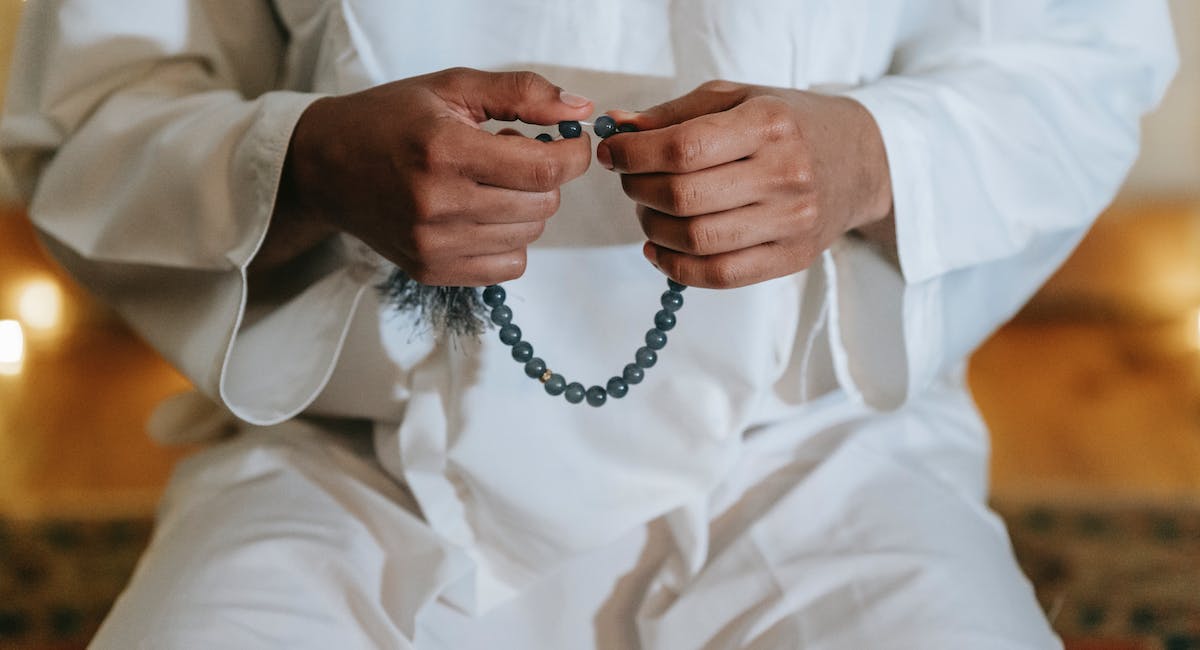
One becomes closer to Allah through the entire act of worship that is Umrah, from having the intention to perform Umrah to carrying it out. Nonetheless, committing oneself to Allah and asking for forgiveness in his presence eliminates one’s soul from previous mistakes. Gaining clarity on questions from Islamic scholars will increase one’s faith in Islam and Allah.
For all Muslims worldwide, the Umrah pilgrimage is immensely fulfilling and helpful. Millions of pilgrims set out on the religious path each year for Allah Ta’ala’s blessings and forgiveness. Furthermore, the Umrah pilgrimage renews a person’s faith in Allah and Islam.
Can non-Muslims go to Makkah?
Non-Muslims are generally prohibited from entering Makkah and the surrounding areas. This prohibition aligns with Islamic law and is mainly in place to protect the sacred sites’ security and sanctity. Makkah, home of the Kaaba and the center of Muslim pilgrimages (the Hajj and Umrah), is the holiest city in Islam. For the Muslim community, the prohibition aims to maintain the rituals’ exclusive character and spiritual atmosphere.
Non-Muslims are, nevertheless, usually welcome to travel to other regions of Saudi Arabia to experience its historical sites and rich cultural legacy. For instance, people of all faiths are welcome to visit the neighboring city of Medina. Travelers must respect and follow the Saudi government’s rules and regulations when entering Makkah and other restricted areas because breaking them could have serious consequences.
Can you touch Kaaba during Umrah?
Umrah pilgrims are permitted to touch or kiss the Kaaba, the sacred cubic structure in Makkah’s Grand Mosque that stands as a reminder of a connection to Allah. Pilgrims frequently express their prayers and devotion while reaching out for this tactile interaction that reinforces unity and humility before this holy House of worship.
Touching the Kaaba was a highly respected and desired act during the Umrah. During the Tawaf, or walking around ritual, pilgrims strive to reach the Black Stone (Hajr-e-Aswad), embedded in one corner of the Kaaba and attempt to touch or kiss it. However, for many pilgrims, it might be difficult to feel the Black Stone directly because of the crowds and the importance of the act.
A simple sign of respect, such as pointing at the Black Stone and reciting “Bismillah” (In the name of Allah), is sufficient in these situations. The ultimate goal is to demonstrate respect and humility toward the Kaaba, which stands for balance and surrender to Allah.
What should a woman do before Umrah?
There are a few requirements that a woman must complete before starting the Umrah.
- She should first and foremost perform Ghusl, a full-body cleansing, to ensure she is in a state of ritual purity.
- She then needs to dress appropriately for Ihram, which usually involves wearing an all-white or colored dress that covers her entire body.
- She should avoid wearing gloves and ensure the headscarf is tied securely.
- Before putting on the Ihram, cutting nails, trimming hair, and removing any extra body hair is crucial.
It is recommended that women introduce themselves to the Umrah rituals, including Tawaf and Sa’i, and comprehend the customs and restrictions related to the pilgrimage. Having the appropriate travel documents, identification, and prescription drugs with you is essential.
Last but not least, cultivating a true and concentrated intention (niyyah) is crucial since Umrah is a profoundly spiritual journey that needs to be done with devotion and humility. Throughout the trip, women are encouraged to pray, reflect, and ask Allah for forgiveness, just like men are.
Women should pack modest yet comfortable clothing that adheres to dress code regulations for pilgrimages. By attending to both logistical and spiritual details of Umrah preparations in this way, women can embark on their pilgrimage experience more meaningful and spiritually fulfilling.
Do girls do Umrah?
Yes, girls and women are encouraged to perform Umrah like any man. Umrah is a pilgrimage that holds significance for all Muslims, regardless of gender, including girls. Women (including girls) can travel to Makkah to perform the associated rituals like Tawaf (circumambulating around Kaaba) and Sa’i (walking between Safa and Marwah), as well as other acts of worship associated with it.
Women must adhere to certain guidelines when participating in pilgrimages, specifically regarding their attire and covering their bodies modestly with Islamic dress codes. Women are expected to observe all rules associated with Ihram, the blessed state, before starting Umrah rituals, including refraining from certain activities during this sacred state. Umrah is an inclusive religious practice open to both men and women of all ages who wish to partake in its spiritual significance pilgrimage.
How many Umrahs can you do in a day?
Umrah pilgrimages do not have any set limits per day, unlike Hajj, which involves multiple dates and rituals over a few days. Umrah is a shorter pilgrimage with fewer mandatory rituals that allows individuals to perform multiple acts each day at their own pace while adhering to any state of Ihram requirements for each act of Umrah they perform; its flexibility also enables individuals to perform multiple Umrah acts during their stay in Makkah; however, its main emphasis should remain sincerity rather than its quantity individuals are encouraged to perform Umrah with mindfulness and reverence rather than on its quantity alone.
How many times can you do Umrah in one trip?
Islamic teachings do not restrict or limit how often someone can perform Umrah on one visit to Makkah; performing it multiple times depends on individual circumstances, time constraints, and personal preferences. Some pilgrims may perform Umrah only once, while others might repeat it multiple times depending on individual intentions, time constraints, and spiritual aspirations.
Performing Umrah allows individuals to participate in rituals at their own pace without specific restrictions imposed by Islamic law, thus offering pilgrims flexibility in engaging rituals at their own pace in line with individual intentions, time constraints, or spiritual aspirations based upon personal circumstances, personal preferences, or religious commitment.
How many hours is Umrah?
Umrah, or Muslim pilgrimages to Makkah, are subject to various factors that determine its length; transportation modes used, rituals performed, and individual preferences can all have an effect. As opposed to Hajj, which takes place on set dates each year, Umrah can occur any time throughout the year.
On average, pilgrims completing Umrah typically complete their rituals within 3 to 6 hours. Pilgrims generally perform the Tawaf (circumambulation of the Kaaba), Sa’i (walking between Safa and Marwa hills), and other practices during their pilgrimage; however, total time spent in Makkah may differ based on factors like travel arrangements, accommodation, or personal choices.
Conclusion
Umrah is a voluntary opportunity for Muslims to come forward and confirm their faith, become closer to Allah, and ask for forgiveness. It is considered a sacred pilgrimage in Islam. Numerous rituals, including Tawaf and Sa’i, which stand for humility, unity, and devotion, are a part of this spiritual journey.
The significance of Umrah lies in the life-changing and cleansing experience it offers millions of Muslims worldwide who make the pilgrimage in search of spiritual development and a closer relationship with Allah, even though it is not required.
From putting on Ihram until finishing Tawaf and Sa’i, the rituals of Umrah function as a structured and symbolic procedure that leads pilgrims through acts of worship that exceed space and time and link followers to the rich religious heritage of their faith.
Muslims can deepen their relationship with Allah and experience the profound spiritual impact of Umrah due to its flexibility, which allows it to be performed at any time of the year. Umrah becomes a voyage of self-discovery and a monument to the unshakable faith of those who make this holy pilgrimage through rituals, prayers, and acts of devotion.
FAQ’s
What is the black box in Makkah?
Makkah, Saudi Arabia, is home to a sacred site known as the Kaaba, one of Islam’s holiest spots. This cubic-shaped building sits in Makkah’s Masjid al-Haram (The Grand Mosque). It is draped in black silk and gold fabric called Kiswah while decorated with golden calligraphy with verses from the Quran written on gold panels.
Is Umrah a mini Hajj?
Umrah is often considered a smaller pilgrimage or “mini Hajj,” as both involve similar rituals and traditions. Hajj is one of the Five Pillars of Islam and is obligatory for eligible Muslims once in their lives, while Umrah is optional and can be done anytime outside of Hajj days.
What do you say when someone completes Umrah?
As soon as someone completes Umrah, it is customary and recommended for others in their community to congratulate and express joy for their achievement. Muslim communities commonly say “Mabrook,” an Arabic term meaning “Congratulations” or “May it be blessed,” to convey good wishes for a successful spiritual journey.
Furthermore, phrases such as “May Allah accept your Umrah” or “May your pilgrimage bring many blessings” can also be used to show the individual’s appreciation and celebrate this achievement.
What are the 5 types of Tawaf?
- Tawaf al-Qudum.
- Tawaf al-Ifadha.
- Tawaf al-Wadaa.
- Tawaf al-Nafl.
- Tawaf al-Umrah.


